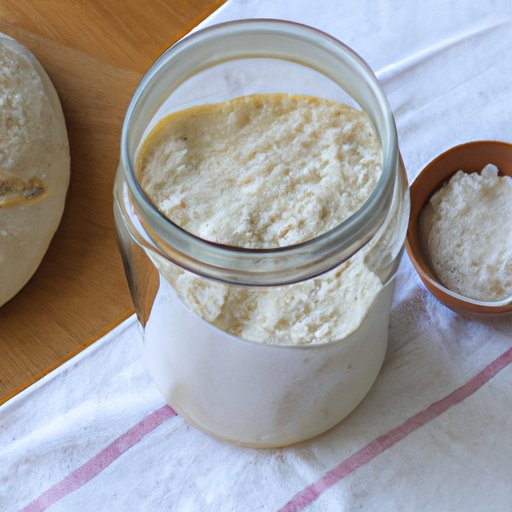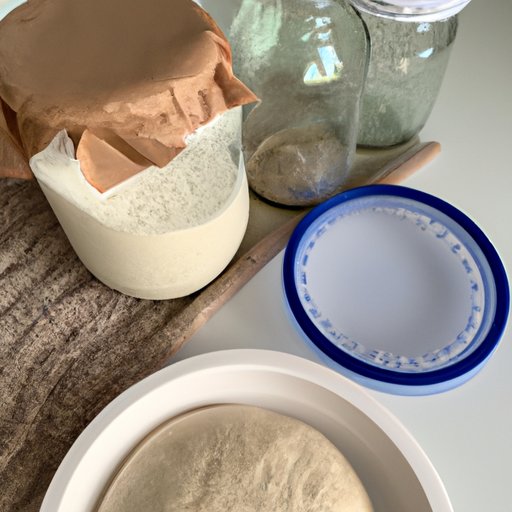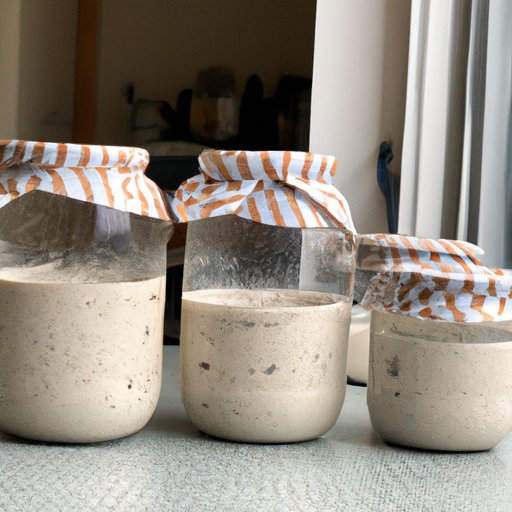Introduction
Making bread from scratch can be a daunting task, but it’s not as difficult as it seems. With the right ingredients and a little bit of patience, anyone can make delicious bread at home. One of the most popular methods of making bread is using sourdough starter, which is a mixture of flour, water, and wild yeast. Sourdough starter has been used for centuries to make bread, and it’s still one of the most popular methods today. In this article, we’ll explore the basics of making bread with sourdough starter, including how to create a starter, how to make the dough, and tips for baking the bread.
Definition of Sourdough Starter
Sourdough starter is a mixture of flour, water, and wild yeast that is used to leaven bread. It is made by combining these three ingredients and allowing them to ferment over a period of time. The fermentation process creates lactic acid and carbon dioxide, which are responsible for the flavor and texture of the bread. Sourdough starter can be made with any type of flour, but it’s usually made with whole wheat or rye flour. Depending on the climate and environment, it can take anywhere from several days to several weeks to create a viable starter.

Overview of the Benefits of Making Bread with Sourdough Starter
Making bread with sourdough starter has numerous benefits. According to a study published in the Journal of Functional Foods, sourdough bread is easier to digest than other types of bread because the fermentation process breaks down some of the carbohydrates and proteins. Additionally, sourdough bread contains beneficial bacteria and probiotics, which may help improve digestion and boost the immune system. Finally, sourdough bread has a unique flavor that can’t be replicated with other methods of making bread.
Step-by-Step Guide to Making Sourdough Bread from Scratch
Making bread from scratch requires a few simple steps. Here’s a step-by-step guide to making sourdough bread from scratch:
Ingredients Needed
To make sourdough bread from scratch, you’ll need the following ingredients:
- Flour (whole wheat, rye, or all-purpose)
- Water
- Salt
- Sourdough starter
Instructions for Creating a Sourdough Starter
The first step in making sourdough bread from scratch is creating a sourdough starter. To do this, combine equal parts flour and water in a bowl and stir until combined. Cover the bowl with a damp cloth and let it sit at room temperature for 12-24 hours. After 12-24 hours, add another equal part of flour and water and stir until combined. Cover the bowl again and let it sit for another 12-24 hours. Repeat this process for 3-5 days, stirring the starter daily. Once the starter is bubbly and smells slightly acidic, it’s ready to use.
Step-by-Step Instructions for Making the Dough
Once the starter is ready, you can begin making the dough. To do this, combine the starter, flour, water, and salt in a large bowl and mix until a dough forms. Knead the dough for 8-10 minutes, then cover the bowl with a damp cloth and let it sit at room temperature for 8-12 hours. After 8-12 hours, the dough should have doubled in size. At this point, you can shape the dough into loaves and let them proof for 1-2 hours before baking.
The Basics of Sourdough Starter and How to Use it to Make Delicious Bread
Now that you know how to make a sourdough starter and how to make the dough, it’s time to learn more about the basics of sourdough starter and how to use it to make delicious bread. Here are a few tips to keep in mind when making bread with sourdough starter:
Understanding the Different Types of Starters
There are two main types of sourdough starters: liquid and stiff. Liquid starters are made with equal parts water and flour, while stiff starters are made with more flour than water. Both types of starters can be used to make bread, but liquid starters tend to produce lighter and airier loaves.
Tips for Maintaining a Healthy Starter
When making sourdough bread, it’s important to maintain a healthy starter. This means feeding your starter regularly with fresh flour and water. Additionally, it’s important to store your starter in a cool, dry place, such as a refrigerator, to prevent it from spoiling.
Troubleshooting Common Problems
If you’re having trouble getting your starter to rise, there are a few things you can do. First, make sure you’re using the right type of flour and water. Second, make sure you’re feeding your starter regularly. Third, make sure you’re storing your starter in a cool, dry place. If you’re still having trouble, consider adding a bit of honey or molasses to your starter to give it an extra boost.

Tips for Beginners: Creating a Sourdough Starter and Baking with it
Creating a sourdough starter and baking with it can be intimidating for beginners, but it doesn’t have to be. Here are a few tips for beginners who want to make sourdough bread from scratch:
Preparing Your Workspace
Before you start making sourdough bread, it’s important to prepare your workspace. Make sure you have all the necessary supplies, such as measuring cups and spoons, a mixing bowl, a wooden spoon, and a damp cloth. Additionally, make sure you have a clean, dry surface to work on.
Gathering the Necessary Supplies
Once you’ve prepared your workspace, it’s time to gather the necessary supplies. You’ll need flour, water, salt, and a sourdough starter. If you don’t have a starter, you can create one yourself using the instructions above. Additionally, you’ll need a baking sheet, parchment paper, and a sharp knife for scoring the dough.
Understanding the Process of Fermentation
Fermentation is an essential part of the sourdough bread-making process. During fermentation, the wild yeast in the starter feeds on the sugars in the flour, producing carbon dioxide and alcohol. This process is what gives sourdough bread its distinctive flavor and texture. To ensure successful fermentation, make sure your starter is active and bubbly before you begin making the dough.
All You Need to Know About Making Bread with Sourdough Starter
Making bread with sourdough starter is a simple process, but there are a few things to keep in mind. Here are a few tips for making the perfect loaf of sourdough bread:
Avoiding Common Mistakes
One of the most common mistakes people make when making sourdough bread is not kneading the dough enough. Make sure you knead the dough for 8-10 minutes before letting it rise. Additionally, make sure you let the dough rise in a warm place – cold temperatures can slow or stop the fermentation process.
Knowing When It’s Ready to Bake
Once the dough has doubled in size, it’s ready to bake. To test if the dough is ready, press your finger into the dough – it should spring back slowly. If it springs back quickly, it needs to rise for longer. Additionally, you can check the internal temperature of the dough with an instant-read thermometer. If the temperature is between 180°F and 200°F, the dough is ready to bake.
The Proper Techniques for Shaping and Baking
Once the dough is ready to bake, it’s time to shape it into loaves and put it in the oven. To shape the dough, lightly flour your work surface and roll the dough into a ball. Place the ball of dough on the floured surface and press it into a flat disc. Fold the edges of the disc inward, then roll the dough up into a tight log. Place the log on a greased baking sheet and score the top with a sharp knife. Finally, bake the bread at 375°F for 40-50 minutes, or until golden brown.

A Comprehensive Guide to Making Sourdough Bread at Home
Making sourdough bread at home doesn’t have to be complicated. With a few simple steps and the right ingredients, anyone can make delicious bread from scratch. Here’s a comprehensive guide to making sourdough bread at home:
Selecting the Right Flour
The type of flour you use can have a big impact on the flavor and texture of the bread. Generally, it’s best to use freshly milled whole wheat flour or rye flour for sourdough bread. However, all-purpose flour can also be used. Avoid using bleached flour, as it can negatively affect the flavor of the bread.
Understanding the Different Stages of the Process
Making sourdough bread involves several different stages. First, you’ll need to create a starter. Then, you’ll need to mix the dough and let it rise. Finally, you’ll need to shape the dough into loaves and bake it. Each stage of the process is important, so make sure you follow the instructions carefully.
Tips for Scoring and Pre-Baking
Before baking the bread, you’ll need to score the top of the loaves. Scoring allows steam to escape during baking, which helps the bread rise properly. To score the loaves, use a sharp knife to make a few shallow cuts on the top of the loaves. Additionally, pre-baking the loaves can help them rise more evenly. To pre-bake the loaves, place them in a 350°F oven for 10 minutes before increasing the heat to 375°F for the remainder of the baking time.
The Art of Baking with Sourdough Starter: An Easy Recipe for Delicious Homemade Bread
Once you’ve mastered the basics of sourdough bread-making, it’s time to move on to more advanced techniques. Here’s an easy recipe for making delicious sourdough bread at home:
Choosing the Right Equipment
The type of equipment you use can have a big impact on the quality of the bread. To make sourdough bread, you’ll need a large bowl, a wooden spoon, and a damp cloth. Additionally, you’ll need a baking sheet, parchment paper, and a sharp knife for scoring the dough.
Making the Dough
To make the dough, combine the starter, flour, water, and salt in a large bowl and mix until a dough forms. Knead the dough for 8-10 minutes, then cover the bowl with a damp cloth and let it sit at room temperature for 8-12 hours. After 8-12 hours, the dough should have doubled in size.
Shaping, Proofing, and Baking
Once the dough has doubled in size, it’s time to shape it into loaves and let them proof. To do this, lightly flour your work surface and roll the dough into a ball. Place the ball of dough on the floured surface and press it into a flat disc. Fold the edges of the disc inward, then roll the dough up into a tight log. Place the log on a greased baking sheet and score the top with a sharp knife. Let the loaves proof for 1-2 hours, then bake at 375°F for 40-50 minutes, or until golden brown.
Conclusion
Making bread from sourdough starter is a simple process that anyone can master with a little practice. By following the steps outlined in this article, you can make delicious sourdough bread at home. Remember to choose the right flour, understand the process of fermentation, and avoid common mistakes. With the right ingredients and a little bit of patience, you can make the perfect loaf of bread every time.
(Note: Is this article not meeting your expectations? Do you have knowledge or insights to share? Unlock new opportunities and expand your reach by joining our authors team. Click Registration to join us and share your expertise with our readers.)
